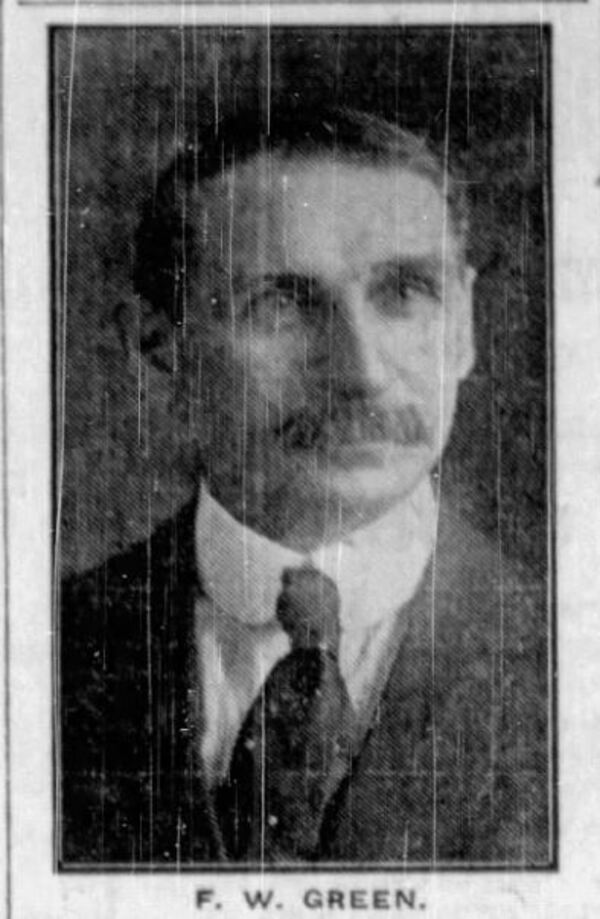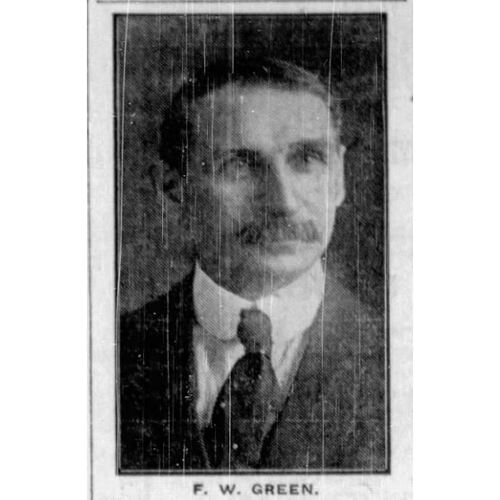
Source: Link
GREEN, FREDERICK WILLIAM, farmer and office holder; b. 30 April 1859 in Rippingale, England, son of Robert Barret Green and Sarah Ann Elsom; m. 1 May 1884 Margaret Anderson, probably in Brandon, Man., and they had six daughters and five sons; d. 13 July 1915 in Montreal.
After spending 16 years of his life on a farm in England, Fred W. Green immigrated with his family to Ontario. He lived with his parents on a rented farm in Lobo Township until the spring of 1882, when, learning that the Canadian Pacific Railway was about to provide access to the prairies, he abandoned Ontario for the west. Having reached Brandon on 1 May, he bought a team of oxen and journeyed westwards into the North-West Territories. Eventually he chose to settle in what was to become Boharm (Sask.), near the future Moose Jaw.
For the next 25 years Green devoted himself to raising a family and developing his farm, which he called Greendale. His skill with machinery – acquired while working in a sawmill and a woollen factory in Ontario – likely contributed to his decision to acquire the first steam-driven thresher in the Moose Jaw district. By 1890 Green had two such machines at work each fall, and by 1910 his farm had expanded to nearly 2,000 acres. His religious outlook is reflected in reports that he would line up his threshing crew each morning and start the day’s work with a prayer.
Green’s success as a farmer was matched by his growing involvement in community affairs. He was an active member of the Moose Jaw Agricultural Society; he served as secretary-treasurer (1897–1900) and chairman (1901–4) of the Boharm school board; and, as a member of the Boharm Mutual Improvement Society, he organized literary nights and took part in debates between the Boharm society and its Moose Jaw counterpart. All these activities prepared Green for a more high-profile position in the farmers’ movement of western Canada.
In 1906 the Territorial Grain Growers’ Association transformed itself into the Saskatchewan Grain Growers’ Association, and the following year Green was elected a director. From this time forward he played a significant and sometimes controversial role in fashioning the SGGA into a permanent and effective organization. He first made his mark at the SGGA’s 1908 convention, when he proposed that life memberships be made available to every farmer upon payment of ten dollars. The funds should be invested, he argued, and the income used for the purposes of the association. Green’s plan was approved. The administration of the trust fund to be generated by the life memberships required the association to ask for legal recognition as a corporate body. This was achieved in June 1908.
In August 1909, after serving for five months as “general organizer” of the SGGA, Green became its secretary-treasurer. In this capacity, he took steps to strengthen the position of the association’s new Moose Jaw headquarters. He was also instrumental in launching a membership drive. Edward Nicholas Hopkins*, president of the association, Edward Alexander Partridge*, and Green spent October 1909 touring the province to persuade farmers “to carry into effect a complete scheme of organization if they wish to raise their standing as a class to the dignity they deserve.” In his report to the 1911 convention, Green stated that membership had increased fivefold from that of 1908 and that the association was now financially sound.
Among the most pressing concerns of prairie farmers was the monopolistic position enjoyed by privately owned and operated local elevators. Partridge advocated federal government ownership of terminal elevators and provincial government ownership of the local “line” elevators, as these private facilities were called. In contrast, Green, who was critical of “the evils of elevator-collected wheat,” opposed any plan that would curtail “the liberty of the farmer in loading at platforms.” He was prepared to accept government ownership for terminal elevators but not for local ones. Instead he proposed the creation of a government-appointed commission which would buy and sell grain and distribute its profits among farmers. His plan, which was rejected as impractical at the time, foreshadowed the demands of farmers in the 1920s for a wheat board.
The Partridge plan was approved in 1907–8 by the farmers’ associations of Manitoba, Saskatchewan, and Alberta, and the inter-provincial council of these organizations then lobbied the three western provinces for the appropriate legislation. Manitoba, under the premiership of Rodmond Palen Roblin*, responded by introducing public ownership of line elevators in 1910 – a scheme which collapsed two years later. Saskatchewan proceeded differently. In 1910 Liberal premier Thomas Walter Scott* appointed a royal commission to investigate the merits of publicly owned elevators. Consisting of Professor Robert Magill* from Dalhousie University, George Langley*, a farmer and a member of the Saskatchewan government, and Fred Green, this commission tabled its report in the legislature in January 1911. It rejected government ownership and recommended instead a farmer-owned and government-subsidized cooperative elevator company. The government accepted the commission’s conclusions and later in 1911 created the Saskatchewan Co-operative Elevator Company; Alberta followed suit in 1913. Both enterprises were immensely successful. Alberta’s cooperative elevator company became part of the United Grain Growers Limited in 1917, and Saskatchewan’s was absorbed into the Saskatchewan Co-operative Wheat Producers Limited (commonly known as the Saskatchewan Wheat Pool) in 1926.
In 1912 Green made a foray into politics. Resenting the provincial Liberal party’s influence in the SGGA, he decided to run in the Saskatchewan election as an “independent farmers’ candidate.” To his misfortune, however, Green announced his candidacy in the riding of Moose Jaw County at the same time that the Conservative candidate withdrew. This coincidence raised suspicions that Green was really a Conservative, suspicions that were reinforced when he accepted funding from the Conservative party. In the end, Green lost the election and also some of his stature in the SGGA.
Green made a contribution to the place of women in the grain growers’ movement. In 1912 he cooperated with Francis Marion Beynon*, an editor and columnist on the Grain Growers’ Guide, in organizing a gathering of farm women which took place in conjunction with the SGGA’s 1913 convention in Saskatoon. The convention agreed to the formation of a women’s auxiliary to the SGGA, and, after it was over, Green expressed his recognition of women’s importance in the farmers’ movement when he stated simply that “you can’t have a home without a woman. Home problems are farm problems.” In fact, Green was a promoter of women’s rights generally. Shortly after the 1913 convention he wrote, “I trust to live to see the day of women’s political emancipation and also the time when women will be protected in our courts by having some of her sex on all juries where women’s honor is at stake.”
Green showed his independence of mind in other ways, too. He opposed suggestions that the SGGA form a third political party because he believed that farmers could exert greater power through apolitical bodies. He rejected demands for the use of the referendum, initiative, and recall on the grounds that such innovations would produce “unstableness and lack of continuity” in government by transferring power from rural areas to the more populous cities. Like many of his contemporaries, Green disliked cities, viewing them as a threat to the agricultural way of life and worrying about the social consequences of their rapidly growing non-British populations.
In February 1914 Green announced his retirement as secretary-treasurer of the SGGA. By this time the Saskatchewan government had passed a bill providing for the incorporation of farmers’ cooperatives to purchase farm supplies. The SGGA was about to establish a trading department to act as a cooperative wholesaler to the local cooperatives formed under the legislation, and Green, anticipating this development, thought that the time had come for him to be replaced by a “fully equipped business manager.” Yet there may have been another reason for his resignation. In a veiled reference to the Liberal ties of most of the SGGA’s leaders, Green, quoting one of his correspondents, stated that “had I served the Gods with half the zeal I have served the people I should not have been left thus naked to mine enemies.”
In appreciation of Green’s efforts on its behalf, the SGGA commissioned a portrait of him which was to be hung at the University of Saskatchewan. Green declined this honour, however, and requested that the moneys donated for the portrait be turned over to the Canadian Patriotic Fund. He continued to be associated with the SGGA as honorary secretary until his death at Montreal in 1915. The significance of his life was perhaps best summed up by Green himself when he said that he had helped to organize farmers into a strong permanent body, “not to oppress others, not to tyrannize over any, but only to secure that which Justice, Fair Play and Equity demand.”
Saskatchewan Arch. Board (Regina), R-73 (R. A. Mayson papers), file no.IV.11 (F. W. Green papers). Saskatchewan Arch. Board (Saskatoon), S-B2 (Saskatchewan Grain Growers’ Assoc.), convention reports, 1902–26. Farmer’s Advocate and Home Journal (Winnipeg), 1906–7. Grain Growers’ Guide (Winnipeg), 1908–15. Moose Jaw Times (Moose Jaw, Sask.), 1890–1906, continued as the Moose Jaw Evening Times, 1906–18. Morning Leader (Regina), 14 July 1915. R. D. Colquette, The first fifty years: a history of the United Grain Growers Limited (Winnipeg, 1957). V. C. Fowke, The National Policy and the wheat economy (Toronto, 1957); “Royal commissions and Canadian agricultural policy,” Canadian Journal of Economics and Political Science (Toronto), 14 (1948): 163–75. Sask., Elevator commission, Report (Regina, 1910). D. S. Spafford, “Independent politics in Saskatchewan before the Nonpartisan League,” Sask. Hist., 18 (1965): 1–9. L. A. Wood, A history of farmers’ movements in Canada (Toronto, 1924; repr., intro. F. J. K. Griezic, Toronto and Buffalo, N.Y., 1975).
Cite This Article
Gordon C. Church, “GREEN, FREDERICK WILLIAM,” in Dictionary of Canadian Biography, vol. 14, University of Toronto/Université Laval, 2003–, accessed January 18, 2026, https://www.biographi.ca/en/bio/green_frederick_william_14E.html.
The citation above shows the format for footnotes and endnotes according to the Chicago manual of style (16th edition). Information to be used in other citation formats:
| Permalink: | https://www.biographi.ca/en/bio/green_frederick_william_14E.html |
| Author of Article: | Gordon C. Church |
| Title of Article: | GREEN, FREDERICK WILLIAM |
| Publication Name: | Dictionary of Canadian Biography, vol. 14 |
| Publisher: | University of Toronto/Université Laval |
| Year of publication: | 1998 |
| Year of revision: | 1998 |
| Access Date: | January 18, 2026 |



